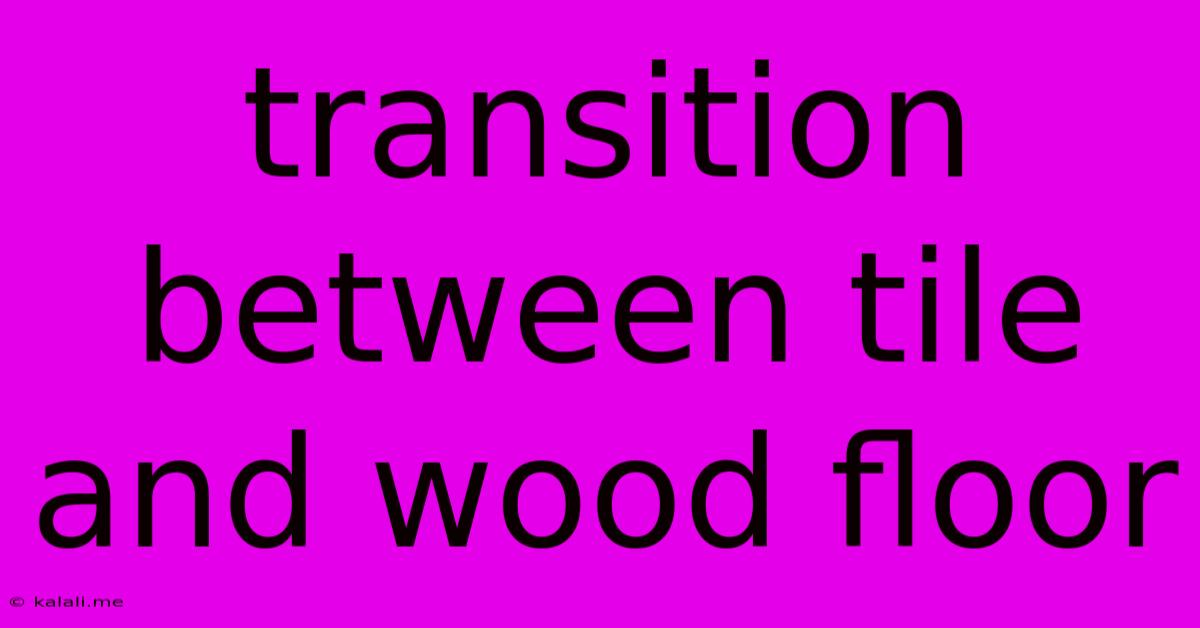Transition Between Tile And Wood Floor
Kalali
Jun 09, 2025 · 3 min read

Table of Contents
Seamless Transitions: Mastering the Art of Tile and Wood Floor Transitions
Choosing between tile and wood flooring often comes down to balancing aesthetics and practicality. Tile's durability and water resistance make it ideal for high-traffic areas like kitchens and bathrooms, while the warmth and natural beauty of hardwood flooring are perfect for living rooms and bedrooms. But what happens when you want both? This article explores the elegant and practical solutions for seamlessly transitioning between tile and wood floors, boosting your home's value and visual appeal. We'll cover various transition methods, materials, and considerations to help you make an informed decision.
Why Choose a Blend of Tile and Wood Flooring?
The combination of tile and wood offers a multitude of benefits. It allows you to leverage the best qualities of each material while creating a visually striking interior. For instance, you might opt for durable tile in your entryway and kitchen, leading to the warmth and comfort of hardwood in your living and dining spaces. This smart combination can also strategically enhance the visual flow of your home.
Popular Transition Methods: A Detailed Look
Several methods ensure a smooth and visually appealing transition between your tile and wood floors:
1. T-Molding: This is a classic and cost-effective solution. The T-molding sits on top of both the tile and wood, creating a clean, finished edge. It's available in various materials like metal, wood, and vinyl to match your flooring styles. Pros: Easy installation, readily available. Cons: Can be less aesthetically pleasing than other options, may show wear over time.
2. Reduce Molding: A sleek, low-profile option designed to create a subtle transition. It sits flush against both floor surfaces, minimizing visual interruption. Pros: Sleek and minimalist look. Cons: Requires precise installation, might not be suitable for significant height differences.
3. Schluter-Systems Profiles: These high-quality, durable profiles offer a wide variety of styles and materials, providing a professional and seamless transition. Schluter offers solutions for various height differences and flooring types. Pros: Durable, elegant, and numerous styles available. Cons: Can be more expensive than other options.
4. Stair Nose Transition: When transitioning between floors on a staircase, a stair nose transition provides a smooth, safe, and aesthetically pleasing finish. It protects the edge of the flooring and provides a nice visual transition from one level to another. Pros: Safe and stylish for staircases. Cons: Specific to stair applications.
5. Custom Thresholds: For a truly bespoke look, consider custom-made thresholds. These can be crafted from wood, metal, or stone to perfectly match your flooring and home's aesthetic. Pros: Highly customizable, unique and elegant. Cons: More expensive and requires specialized craftsmanship.
Choosing the Right Materials: Factors to Consider
The material of your transition piece is crucial. Consider these factors:
- Durability: Opt for materials that can withstand heavy foot traffic and potential damage.
- Moisture Resistance: In areas with high humidity, choose moisture-resistant materials to prevent damage.
- Aesthetics: Select a material that complements your flooring and overall home décor.
- Matching Colors and Finishes: Ensure the transition piece matches or complements the colors and finishes of both the tile and wood flooring.
Preparing for Installation: Key Steps
Before installation, it’s essential to:
- Measure Accurately: Accurate measurements are crucial for selecting the appropriate transition piece and ensuring a perfect fit.
- Proper Flooring Preparation: Ensure both the tile and wood flooring are level and properly installed.
- Professional Installation: While some methods are DIY-friendly, professional installation guarantees a flawless and long-lasting result, especially for complex transitions or higher-end materials.
By carefully considering the various transition methods and materials, you can create a seamless and visually appealing blend of tile and wood floors in your home, enhancing both functionality and style. Remember to prioritize the durability, aesthetics, and overall functionality that best suit your individual needs and budget.
Latest Posts
Latest Posts
-
How To Tell If Ballast Is T8 Or T12
Jun 09, 2025
-
How To Reload Spawns In Minecraft Chunks
Jun 09, 2025
-
Does Revving The Engine In Park Damage It
Jun 09, 2025
-
3 Way Motion Detector Rocker Switches
Jun 09, 2025
-
How To Clean A Jacuzzi Bathtub
Jun 09, 2025
Related Post
Thank you for visiting our website which covers about Transition Between Tile And Wood Floor . We hope the information provided has been useful to you. Feel free to contact us if you have any questions or need further assistance. See you next time and don't miss to bookmark.